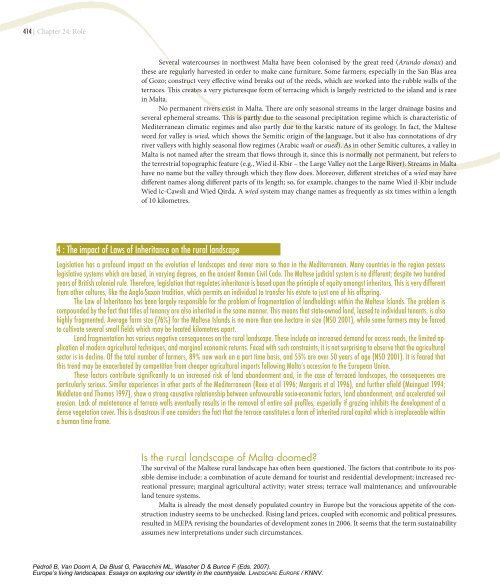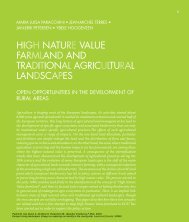The Terraced landscapes of The MalTese Islands - Landscape Europe
The Terraced landscapes of The MalTese Islands - Landscape Europe
The Terraced landscapes of The MalTese Islands - Landscape Europe
Create successful ePaper yourself
Turn your PDF publications into a flip-book with our unique Google optimized e-Paper software.
1 | Chapter 24: Rolé<br />
Several watercourses in northwest Malta have been colonised by the great reed (Arundo donax) and<br />
these are regularly harvested in order to make cane furniture. Some farmers; especially in the San Blas area<br />
<strong>of</strong> Gozo; construct very effective wind breaks out <strong>of</strong> the reeds, which are worked into the rubble walls <strong>of</strong> the<br />
terraces. This creates a very picturesque form <strong>of</strong> terracing which is largely restricted to the island and is rare<br />
in Malta.<br />
No permanent rivers exist in Malta. <strong>The</strong>re are only seasonal streams in the larger drainage basins and<br />
several ephemeral streams. This is partly due to the seasonal precipitation regime which is characteristic <strong>of</strong><br />
Mediterranean climatic regimes and also partly due to the karstic nature <strong>of</strong> its geology. In fact, the Maltese<br />
word for valley is wied, which shows the Semitic origin <strong>of</strong> the language, but it also has connotations <strong>of</strong> dry<br />
river valleys with highly seasonal flow regimes (Arabic wadi or oued). As in other Semitic cultures, a valley in<br />
Malta is not named after the stream that flows through it, since this is normally not permanent, but refers to<br />
the terrestrial topographic feature (e.g., Wied il-Kbir – the Large Valley not the Large River). Streams in Malta<br />
have no name but the valley through which they flow does. Moreover, different stretches <strong>of</strong> a wied may have<br />
different names along different parts <strong>of</strong> its length; so, for example, changes to the name Wied il-Kbir include<br />
Wied ic-Cawsli and Wied Qirda. A wied system may change names as frequently as six times within a length<br />
<strong>of</strong> 10 kilometres.<br />
: <strong>The</strong> impact <strong>of</strong> Laws <strong>of</strong> Inheritance on the rural landscape<br />
Legislation has a pr<strong>of</strong>ound impact on the evolution <strong>of</strong> <strong>landscapes</strong> and never more so than in the Mediterranean. Many countries in the region possess<br />
legislative systems which are based, in varying degrees, on the ancient Roman Civil Code. <strong>The</strong> Maltese judicial system is no different; despite two hundred<br />
years <strong>of</strong> British colonial rule. <strong>The</strong>refore, legislation that regulates inheritance is based upon the principle <strong>of</strong> equity amongst inheritors. This is very different<br />
from other cultures, like the Anglo-Saxon tradition, which permits an individual to transfer his estate to just one <strong>of</strong> his <strong>of</strong>fspring.<br />
<strong>The</strong> Law <strong>of</strong> Inheritance has been largely responsible for the problem <strong>of</strong> fragmentation <strong>of</strong> landholdings within the Maltese <strong>Islands</strong>. <strong>The</strong> problem is<br />
compounded by the fact that titles <strong>of</strong> tenancy are also inherited in the same manner. This means that state-owned land, leased to individual tenants, is also<br />
highly fragmented. Average farm size (76%) for the Maltese <strong>Islands</strong> is no more than one hectare in size (NSO 2001), while some farmers may be forced<br />
to cultivate several small fields which may be located kilometres apart.<br />
Land fragmentation has various negative consequences on the rural landscape. <strong>The</strong>se include an increased demand for access roads, the limited application<br />
<strong>of</strong> modern agricultural techniques, and marginal economic returns. Faced with such constraints, it is not surprising to observe that the agricultural<br />
sector is in decline. Of the total number <strong>of</strong> farmers, 89% now work on a part time basis, and 55% are over 50 years <strong>of</strong> age (NSO 2001). It is feared that<br />
this trend may be exacerbated by competition from cheaper agricultural imports following Malta’s accession to the <strong>Europe</strong>an Union.<br />
<strong>The</strong>se factors contribute significantly to an increased risk <strong>of</strong> land abandonment and, in the case <strong>of</strong> terraced <strong>landscapes</strong>, the consequences are<br />
particularly serious. Similar experiences in other parts <strong>of</strong> the Mediterranean (Roxo et al 1996; Margaris et al 1996), and further afield (Mainguet 1994;<br />
Middleton and Thomas 1997), show a strong causative relationship between unfavourable socio-economic factors, land abandonment, and accelerated soil<br />
erosion. Lack <strong>of</strong> maintenance <strong>of</strong> terrace walls eventually results in the removal <strong>of</strong> entire soil pr<strong>of</strong>iles, especially if grazing inhibits the development <strong>of</strong> a<br />
dense vegetation cover. This is disastrous if one considers the fact that the terrace constitutes a form <strong>of</strong> inherited rural capital which is irreplaceable within<br />
a human time frame.<br />
Is the rural landscape <strong>of</strong> Malta doomed?<br />
<strong>The</strong> survival <strong>of</strong> the Maltese rural landscape has <strong>of</strong>ten been questioned. <strong>The</strong> factors that contribute to its possible<br />
demise include: a combination <strong>of</strong> acute demand for tourist and residential development; increased recreational<br />
pressure; marginal agricultural activity; water stress; terrace wall maintenance; and unfavourable<br />
land tenure systems.<br />
Malta is already the most densely populated country in <strong>Europe</strong> but the voracious appetite <strong>of</strong> the construction<br />
industry seems to be unchecked. Rising land prices, coupled with economic and political pressures,<br />
resulted in MEPA revising the boundaries <strong>of</strong> development zones in 2006. It seems that the term sustainability<br />
assumes new interpretations under such circumstances.<br />
Pedroli B, Van Doorn A, De Blust G, Paracchini ML, Wascher D & Bunce F (Eds. 2007).<br />
<strong>Europe</strong>’s living <strong>landscapes</strong>. Essays on exploring our identity in the countryside. LANDSCAPE EUROPE / KNNV.




